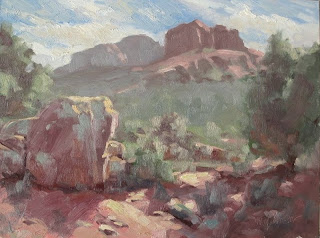
"From the Ridge Trail" 9x12, oil - contact Michael
One of the benefits I claim for painting from life is that you learn to see, to really see. The mere act of comparing what you're putting down on canvas (or paper) to that what's before you opens up your eyes.
I'm sure you've all heard this before. But you may not have heard that there's a downside to painting from life - it's in seeing too much.
If you use a viewfinder, you may think you've avoided that problem by narrowing down your field of view. Not so. No matter how small a field you select, no matter how microscopically you zoom in, there is still the danger of seeing too much. Many of my less-experienced students will latch onto some rocky cliff and try to reproduce every cleft and crack. Or they'll focus on a grassy sward and try to get the exact patterning of grass blades, weed stalks and stray fallen twigs. Most of these students are advanced enough to tell you they know the point of painting isn't to make a photograph. But yet they're doing exactly just that. So what's going on?
It's our natural attraction to the beauty of subtle color and value shifts and the things that demonstrate these shifts. Anytime we get lost in the cracks or in the grassy sward, it's because we've been seduced by the scene's lesser elements. It's important to stick with the big picture - the large shapes, the large contrasts in color and value - and to only suggest everything else. Blurring line, softening edges, introducing a hint of the subtle treasures, will help.
In the painting above, there was a lot of interesting stuff going on in both the shadowed plane of the big rock and in the foreground. But the clouds were moving in and I was running out of time, so I was forced to leave some things unsaid. I think the painting works better because of it.
